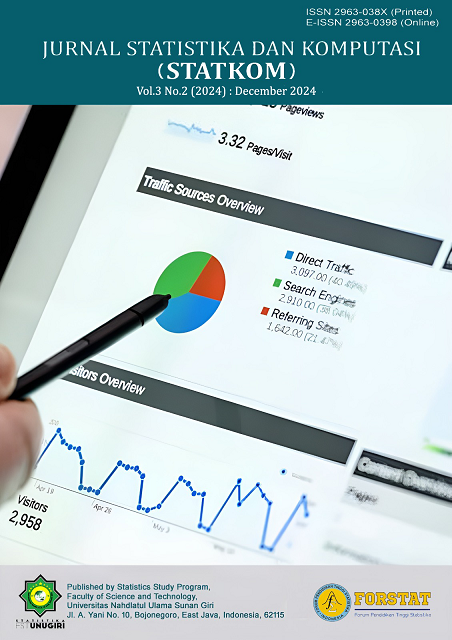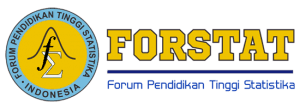Pengelompokkan Wilayah Banjir di Jawa Tengah untuk Mitigasi Banjir Menggunakan Pendekatan K-Medoids
 PDF Download: 251
SIMILARITY INDEX Download: 0
PDF Download: 251
SIMILARITY INDEX Download: 0
DOI:
https://doi.org/10.32665/statkom.v3i2.3223Keywords:
Clustering, K-Medoids, Silhoutte Coefficient, FloodingAbstract
Background: Flooding is a natural event that can occur at any time, often resulting in fatalities and significant material losses. Mapping flood zones in Central Java based on flood occurrences is crucial for optimizing disaster management. Clustering approaches are highly relevant and potential methods for tackling flood mitigation challenges in Central Java.
Objective: To map flood zoning in Central Java using the optimal K-Medoids method based on the Silhouette Coefficient.
Methods: This study uses the K-Medoids method for Clustering analysis because it is more resistant to outliers. Unlike K-Means, K-Medoids selects the medoid as the cluster center, making it more stable against extreme values. The data used was obtained from the Dinas PUSDATARU of Central Java Province regarding flood events in the region from October 1, 2022, to March 2023.
Results: The K-Medoids method with k=2 produced the highest Silhouette Coefficient of 0.83748, Clustering 34 districts/cities with low flood occurrences and 1 district/city with high flood occurrences. This model evaluation supports the planning of disaster mitigation policies that focus more on flood-prone areas.
Conclusion: There are two groups of districts/cities based on flood occurrence levels. The high Silhouette Coefficient value indicates a good cluster structure.
References
Botyarov, M., & Miller, E. E. (2022). Partitioning around medoids as a systematic approach to generative design solution space reduction. Results in Engineering, 15, 100544. https://doi.org/10.1016/j.rineng.2022.100544
Dino. (2023). Banjir: Pengertian, Penyebab, dan Dampaknya. BPDB Jatim. https://web.bpbd.jatimprov.go.id/2023/10/19/banjir-pengertian-penyebab-dan-dampaknya/
Doi, M. D., Rusgiyono, A., & Wuryandari, T. (2023). ANALISIS k-MEDOIDS DENGAN VALIDASI INDEKS PADA IPM DAERAH 3T DI INDONESIA. Jurnal Gaussian, 12(2), 178–188. https://doi.org/10.14710/j.gauss.12.2.178-188
Farissa, R. A., Mayasari, R., & Umaidah, Y. (2021). Perbandingan Algoritma K-Means dan K-Medoids Untuk Pengelompokkan Data Obat dengan Silhouette Coefficient di Puskesmas Karangsambung. Journal of Applied Informatics and Computing, 5(2), 109–116. https://doi.org/10.30871/jaic.v5i1.3237
Hadi, B. S. (2024). BNPB: Indonesia Alami 4.940 Kali Bencana Selama 2023. Antara News. https://www.antaranews.com/berita/3912381/bnpb-indonesia-alami-4940-kali-bencana-selama-2023
Haumahu, G., & Matdoan, M. Y. (2023). ALGORITMA K-MEDOIDS CLUSTERING UNTUK MENGELOMPOKKAN TINGKAT KEMISKINAN PADA KABUPATEN DAN KOTA DI KEPULAUAN MALUKU DAN PAPUA. VARIANCE: Journal of Statistics and Its Applications, 4(2), 81–88. https://doi.org/10.30598/variancevol4iss2page81-87
Hidayat, R. S., Muttaqin, M. R., & Irmayanti, D. (2024). PENGELOMPOKAN DAERAH RAWAN BENCANA DI JAWA TENGAH MENGGUNAKAN ALGORITMA K-MEANS CLUSTERING. JATI (Jurnal Mahasiswa Teknik Informatika), 8(5), 10035–10042. https://doi.org/10.36040/jati.v8i5.10880
Iklima, T., & Pujiyanta, A. (2023). Perbandingan Metode K-Means Clustering Dan Metode Ward Dalam Mengelompokkan Pelangan Mall. JURNAL FASILKOM, 13(3), 349–357. https://doi.org/10.37859/jf.v13i3.6040
Iman, A. N. (2023). BPBD Jateng: Kerugian Akibat Banjir Awal 2023 Capai Rp 16 M. Detik Jateng. https://www.detik.com/jateng/berita/d-6510107/bpbd-jateng-kerugian-akibat-banjir-awal-2023-capai-rp-16-m
Kamila, I., Khairunnisa, U., & Mustakim, M. (2019). Perbandingan Algoritma K-Means dan K-Medoids untuk Pengelompokan Data Transaksi Bongkar Muat di Provinsi Riau. Jurnal Ilmiah Rekayasa Dan Manajemen Sistem Informasi, 5(1), 53–68. https://doi.org/10.24014/rmsi.v5i1.7381
Khan, A. S. S., Fatekurohman, M., & Dewi, Y. S. (2023). Perbandingan Algoritma K-Medoids Dan K-Means Dalam Pengelompokan Kecamatan Berdasarkan Produksi Padi Dan Palawija Di Jember. Jurnal Statistika Dan Komputasi, 2(2), 67–75. https://doi.org/10.32665/statkom.v2i2.2301
Martins, A. S. C., Araujo, L. R. de, & Penido, D. R. R. (2024). K-Medoids clustering applications for high-dimensionality multiphase probabilistic power flow. International Journal of Electrical Power & Energy Systems, 157, 109861. https://doi.org/10.1016/j.ijepes.2024.109861
Nahdliyah, M. A., Widiharih, T., & Prahutama, A. (2019). METODE k-MEDOIDS CLUSTERING DENGAN VALIDASI SILHOUETTE INDEX DAN C-INDEX (Studi Kasus Jumlah Kriminalitas Kabupaten/Kota di Jawa Tengah Tahun 2018). Jurnal Gaussian, 8(2), 161–170. https://doi.org/https://doi.org/10.14710/j.gauss.8.2.161-170
Novianti, A., Afnan, I. M., Utama, R. I. B., & Widodo, E. (2021). Grouping of Districts Based on Poverty Factors in Papua Province Uses The K-Medoids Algorithm. Enthusiastic : International Journal of Applied Statistics and Data Science, 1(2), 94–102. https://doi.org/10.20885/enthusiastic.vol1.iss2.art6
Paembonan, S., & Abduh, H. (2021). Penerapan Metode Silhouette Coefficient untuk Evaluasi Clustering Obat. PENA TEKNIK: Jurnal Ilmiah Ilmu-Ilmu Teknik, 6(2), 48–54. https://doi.org/10.51557/pt_jiit.v6i2.659
Rahayu, N. D., Sasmito, B., & Bashit, N. (2018). ANALISIS PENGARUH FENOMENA INDIAN OCEAN DIPOLE (IOD) TERHADAP CURAH HUJAN DI PULAU JAWA. Jurnal Geodesi Undip, 7(1), 57–67. https://doi.org/https://doi.org/10.14710/jgundip.2017.19299
Rahmawati, T., Wilandari, Y., & Kartikasari, P. (2024). ANALISIS PERBANDINGAN SILHOUETTE COEFFICIENT DAN METODE ELBOW PADA PENGELOMPOKKAN PROVINSI DI INDONESIA BERDASARKAN INDIKATOR IPM DENGAN K-MEDOIDS. Jurnal Gaussian, 13(1), 13–24. https://doi.org/10.14710/j.gauss.13.1.13-24
Sindi, S., Ningse, W. R. O., Sihombing, I. A., R.H.Zer, F. I., & Hartama, D. (2020). ANALISIS ALGORITMA K-MEDOIDS CLUSTERING DALAM PENGELOMPOKAN PENYEBARAN COVID-19 DI INDONESIA. Jurnal Teknologi Informasi, 4(1), 166–173. https://doi.org/10.36294/jurti.v4i1.1296
Sukmayadi, C., Primajaya, A., & Maulana, I. (2021). Penerapan Algoritma K-Medoids dalam Menentukan Daerah Rawan Banjir di Kabupaten Karawang. INFORMAL: Informatics Journal, 6(3), 187–196. https://doi.org/10.19184/isj.v6i3.25423
Tambunan, H. B., Barus, D. H., Hartono, J., Alam, A. S., Nugraha, D. A., & Usman, H. H. H. (2020). Electrical Peak Load Clustering Analysis Using K-Means Algorithm and Silhouette Coefficient. 2020 International Conference on Technology and Policy in Energy and Electric Power (ICT-PEP), 258–262. https://doi.org/10.1109/ICT-PEP50916.2020.9249773
Wira, B., Budianto, A. E., & Wiguna, A. S. (2019). IMPLEMENTASI METODE K-MEDOIDS CLUSTERING UNTUK MENGETAHUI POLA PEMILIHAN PROGRAM STUDI MAHASIWA BARU TAHUN 2018 DI UNIVERSITAS KANJURUHAN MALANG. RAINSTEK : Jurnal Terapan Sains & Teknologi, 1(3), 53–68. https://doi.org/10.21067/jtst.v1i3.3046
Downloads
Additional Files
Published
How to Cite
Issue
Section
License
Copyright (c) 2024 Safril Ahmadi Sanmas, Rahma Nurmalita, Dwi Sulistiyani, M. Al Haris

This work is licensed under a Creative Commons Attribution-ShareAlike 4.0 International License.
Authors who publish with this journal agree to the following terms:
- Authors retain copyright and grant the journal right of first publication with the work simultaneously licensed under a Creative Commons Attribution License - Share Alike that allows others to share the work with an acknowledgment of the work's authorship and initial publication in this journal.
- Authors are able to enter into separate, additional contractual arrangements for the non-exclusive distribution of the journal's published version of the work (e.g., post it to an institutional repository or publish it in a book), with an acknowledgment of its initial publication in this journal.
- Authors are permitted and encouraged to post their work online (e.g., in institutional repositories or on their website) prior to and during the submission process, as it can lead to productive exchanges, as well as earlier and greater citation of published work.
USER RIGHTS
All articles published Open Access will be immediately and permanently free for everyone to read and download. We are continuously working with our author communities to select the best choice of license options, currently being defined for this journal as follows:
 PDF Download: 251
SIMILARITY INDEX Download: 0
PDF Download: 251
SIMILARITY INDEX Download: 0














